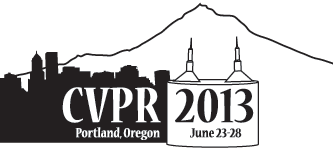-
GeoF: Geodesic Forests for Learning Coupled Predictors
AbstractConventional decision forest based methods for image labelling tasks like object segmentation make predictions for each variable (pixel) independently [3, 5, 8]. This prevents them from enforcing dependencies between variables and translates into locally inconsistent pixel labellings. Random field models, instead, encourage spatial consistency of labels at increased computational expense. This paper presents a new and efficient forest based model that achieves spatially consistent semantic image segmentation by encoding variable dependencies directly in the feature space the forests operate on. Such correlations are captured via new long-range, soft connectivity features, computed via generalized geodesic distance transforms. Our model can be thought of as a generalization of the successful Semantic Texton Forest, Auto-Context, and Entangled Forest models. A second contribution is to show the connection between the typical Conditional Random Field (CRF) energy and the forest training objective. This analysis yields a new objective for training decision forests that encourages more accurate structured prediction. Our GeoF model is validated quantitatively on the task of semantic image segmentation, on four challenging and very diverse image datasets. GeoF outperforms both stateof-the-art forest models and the conventional pairwise CRF.
Related Material
[pdf][bibtex]@InProceedings{Kontschieder_2013_CVPR,
author = {Kontschieder, Peter and Kohli, Pushmeet and Shotton, Jamie and Criminisi, Antonio},
title = {GeoF: Geodesic Forests for Learning Coupled Predictors},
booktitle = {Proceedings of the IEEE Conference on Computer Vision and Pattern Recognition (CVPR)},
month = {June},
year = {2013}
}
These CVPR 2013 papers are the Open Access versions, provided by the Computer Vision Foundation.
Except for the watermark, they are identical to the accepted versions; the final published version of the proceedings is available on IEEE Xplore.
Except for the watermark, they are identical to the accepted versions; the final published version of the proceedings is available on IEEE Xplore.
This material is presented to ensure timely dissemination of scholarly and technical work.
Copyright and all rights therein are retained by authors or by other copyright holders.
All persons copying this information are expected to adhere to the terms and constraints invoked by each author's copyright.

